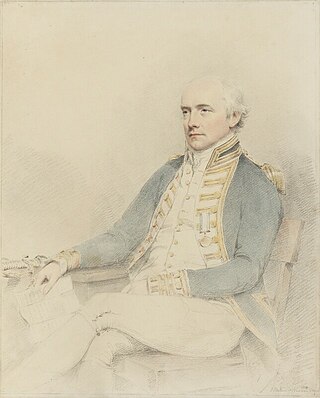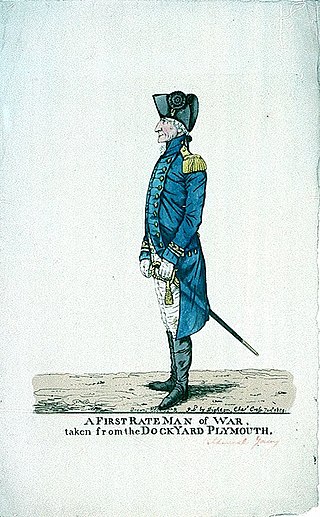
Admiral of the Fleet James Gambier, 1st Baron Gambier, was a Royal Navy officer. After seeing action at the capture of Charleston during the American Revolutionary War, he saw action again, as captain of the third-rate HMS Defence, at the battle of the Glorious First of June in 1794, during the French Revolutionary Wars, gaining the distinction of commanding the first ship to break through the enemy line.

Admiral Sir John Thomas Duckworth, 1st Baronet, GCB was an English officer of the Royal Navy, serving during the Seven Years' War, the American War of Independence, the French Revolutionary and Napoleonic wars, as the Governor of Newfoundland during the War of 1812, and a member of the British House of Commons during his semi-retirement. Duckworth, a vicar's son, achieved much in a naval career that began at the age of 11.

The Battle of the Basque Roads, also known as the Battle of Aix Roads, was a major naval battle of the Napoleonic Wars, fought in the narrow Basque Roads at the mouth of the Charente River on the Biscay coast of France. The battle, which lasted from 11–24 April 1809, was unusual in that it pitted a hastily-assembled squadron of small and unorthodox British Royal Navy warships against the main strength of the French Atlantic Fleet. The circumstances were dictated by the cramped, shallow coastal waters in which the battle was fought. The battle is also notorious for its controversial political aftermath in both Britain and France.

Admiral Sir Robert Stopford was a British Royal Navy officer and politician whose career spanned over 60 years, from the French Revolutionary Wars to the Egyptian–Ottoman War.

Admiral Sir Pulteney Malcolm was a British naval officer. He was born at Douglan, near Langholm, Scotland, on 20 February 1768, the third son of George Malcolm of Burnfoot, Langholm, in Dumfriesshire, a sheep farmer, and his wife Margaret, the sister of Admiral Sir Thomas Pasley. His brothers were Sir James Malcolm, Sir John Malcolm, and Sir Charles Malcolm.
Vice-Admiral Edward Stirling Dickson was a Royal Navy officer who served in the American Revolutionary War, the French Revolutionary Wars, and the Napoleonic Wars.

Admiral John Erskine Douglas was a senior British Royal Navy officer of the early nineteenth century who served in a number of vessels and participated at the destruction of the French ship of the line Impétueux in 1806 and the victory over the French off Brest during the Battle of Basque Roads in 1809. He also served in the Mediterranean and off Norfolk, Virginia, where he gained notoriety by searching American vessels for British deserters without asking permission from the American authorities. He later served as commander in chief at Jamaica and rose through the ranks to full admiral. He amassed a fortune, and when he died Douglas left over 40,000l. to his daughters.

Surveillante entered service as a 40-gun Virginie-class frigate of the French Navy. She was surrendered to the British in 1803, after which she served in the Royal Navy, classed under the British system as a 38-gun vessel, until 1814 when she was decommissioned. HMS Surveillante had a long and active career under two successful and distinguished commanders, from the Baltic to the northwestern coasts of France, Spain and Portugal, and was present at the Battle of Copenhagen (1807) and throughout the Peninsula War. Her record as a taker of prizes is notable for its success, particularly towards the end of her career.

The Battle of Les Sables-d'Olonne was a minor naval battle fought on 23 February 1809 off the town of Les Sables-d'Olonne on the Biscay Coast of France between a French Navy squadron of three frigates and a larger British squadron of ships of the line. The French squadron had sailed from the port of Lorient on 23 February in an effort to link up with a fleet from Brest under Jean-Baptiste Willaumez, but missed the rendezvous and was pursued by a British blockade squadron under Rear-Admiral Robert Stopford. The French commander, Commodore Pierre Roch Jurien, anchored his squadron under the batteries which protected the town of Les Sables-d'Olonne in the hope of dissuading an attack.

Admiral Sir William Young GCB was an officer of the Royal Navy who saw service during the American War of Independence, and the French Revolutionary and Napoleonic Wars. He should not be confused with his namesake and near contemporary Admiral William Young.

HMS Hussar was a 28-gun Enterprise-class sixth-rate frigate of the Royal Navy. Hussar was first commissioned in May 1790 under the command of Captain Eliab Harvey.
Rear-Admiral Edward Sneyd Clay was an officer of the Royal Navy who served during the American War of Independence, and the French Revolutionary and Napoleonic Wars.
Rear-Admiral Sir George Burlton KCB was an officer of the Royal Navy during the Napoleonic Wars.

Rear-Admiral John Bligh CB was an officer in the Royal Navy who served during the American War of Independence and the French Revolutionary and Napoleonic Wars.

Prévoyante was the second of two flûtes built to a design by Raymond-Antoine Haran. She was launched in May 1793 at Bayonne. The British frigates HMS Thetis and HMS Hussar captured Prévoyante in 1795 and the British took her into the Royal Navy after first converting her to a fifth rate. She served as a frigate until 1800, when she underwent reconversion back to a store ship. As a store ship she sailed to the Mediterranean, Cape of Good Hope, and Quebec. She was sold for breaking up in July 1819.

Admiral Sir Henry Edwyn Stanhope, 1st Baronet was a Royal Navy officer who became Commander-in-Chief, The Nore.

The Court-martial of James, Lord Gambier, was a notorious British naval legal case during the summer of 1809, in which Admiral Lord Gambier requested a court-martial to examine his behaviour during the Battle of Basque Roads in April of the same year. Noted for the acrimony and corruption of proceedings, it has been described as "one of the ugliest episodes in the internal history of the Royal Navy".
Admiral Thomas Le Marchant Gosselin was a British naval officer of the 18th and 19th centuries who received the patronage of senior officers such as Samuel Hood, 1st Viscount Hood and William Cornwallis. Gosselin joined the Royal Navy in 1778 and as a junior officer had extensive service in the American Revolution, including participating in the Battle of the Saintes in April 1782. Promoted to commander in April 1793, Gosselin took part in the Glorious First of June as commander of HMS Kingfisher. He was promoted to post-captain in July 1795 and took command of a variety of ships including most notably HMS Syren, HMS Latona, and HMS Audacious. Gosselin frequently served on blockade duties in the English Channel and on convoy duties to and from the West Indies.

Vice-Admiral Sir Charles Richardson was a British naval officer of the 18th and 19th centuries. His naval career began when he joined HMS Vestal as a captain's servant in 1787. In Vestal he made an aborted journey to China before serving on the East Indies Station where he transferred to HMS Phoenix and fought in the Battle of Tellicherry and the Third Anglo-Mysore War in 1791 and 1792. Having returned to England as a master's mate, Richardson fought at the Glorious First of June on HMS Royal George in 1794 before being promoted to lieutenant in HMS Circe. In 1797, he successfully combated the Nore mutiny in Circe before fighting in the Battle of Camperdown where he personally captured the Dutch admiral Jan Willem de Winter. Afterwards he became flag lieutenant to Admiral Adam Duncan and fought at the Battle of Callantsoog and the Vlieter Incident in the Anglo-Russian invasion of Holland of 1799. He then sailed to Egypt in HMS Kent where he again went onshore, fighting in the battles of Abukir, Mandora, and Alexandria in 1801.

Captain Joseph Ellison was a Royal Navy officer. Having joined the service at the age of nine, he served during the Falklands Crisis in 1770 and went on to participate in the Battle of Bunker Hill and Siege of Pondicherry during the American Revolutionary War, during which he was promoted to lieutenant. On 4 July 1780 Ellison was serving on board HMS Prudente when they engaged, with another British frigate, two French frigates off Cape Ortegal. Ellison was badly wounded in the back during the battle and had an arm destroyed by a cannon ball that was amputated after the British had attained their victory. Having recuperated from his injuries Ellison was appointed to the impress service where he performed so well that he was promoted to commander in 1782 and post-captain in 1783. He took command of HMS Ariadne in April of that year and served in her off Ireland investigating fisheries, but in September he temporarily retired from the navy when his wounds began to become more problematic.















